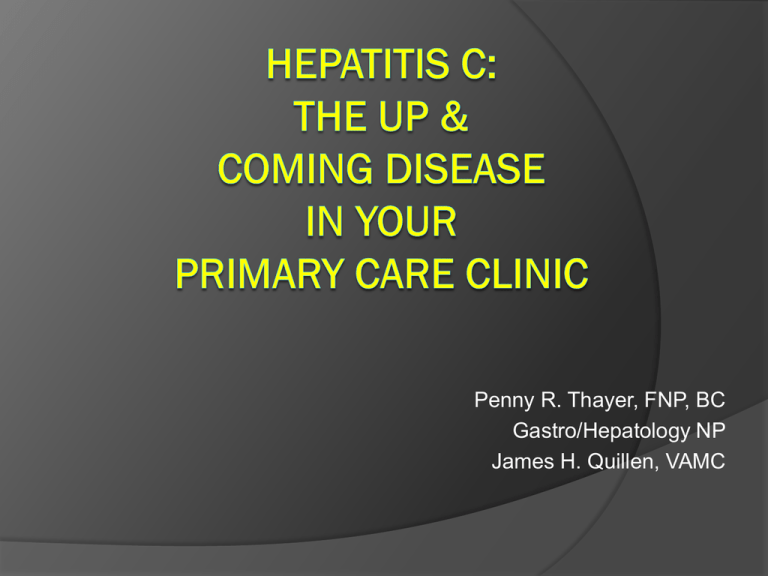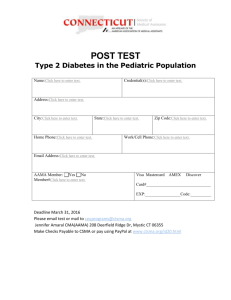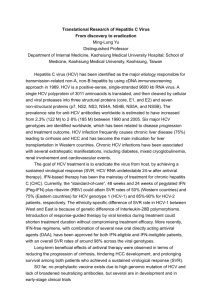Penny R. Thayer, FNP, BC Gastro/Hepatology NP James H. Quillen, VAMC
advertisement

Penny R. Thayer, FNP, BC Gastro/Hepatology NP James H. Quillen, VAMC OBJECTIVES PREVALENCE IDENTIFY RISK FACTORS TREATMENT OPTIONS COMMON SIDE EFFECTS OF ANTIVIRAL THERAPY APPROPRIATE CODING FACES OF THE DISEASE PREVALENCE NHANES IV (1999-2002)1 1.6% anti-HCV positive (95% CI 1.3-1.9%) = 4.1 million persons (95% CI 3.4-4.9 million) 1.3% chronic infection = 3.2 million persons Peak prevalence age 40-49 (4.3%) Three characteristics identified 85.1% all infections: abnormal serum ALT, ever IVDU, transfusion <1992 Most persons born 1945-1964 Armstrong GL, Wasley A, Simard E, et al. Ann Intern Med 2006; 144: 705-14. TESTING FOR HCV AB Recent/past injection drug users—even if only used once Recipients of transfusion or transplantation before July 1992 Groups with high HCV prevalence Children born to women infected with HCV HIV-infected individuals Healthcare, public safety, and emergency medical personnel following needle injury or mucosal exposure to HCV-infected blood Current sexual partners of individuals infected with HCV Persons who have used illicit drugs by noninjection routes Hemophiliacs treated with clotting factor concentrates before 1987 Hemodialysis recipients Patients with unexplained aminotransferase abnormalities DIAGNOSIS Positive Hepatitis C antibody-exposure Positive Hepatitis C RNA (PCR) RIBA Generally asymptomatic Acute Hepatitis C PROGRESSION ACUTE HEPATITIS C 15-40% will spontaneously resolve, generally within the first 6-18 months after acute onset. 60-85% will progress to chronic infection CHRONIC 85-90% stable 10-15% progress to cirrhosis PROGRESSION CIRRHOSIS 75% slowly progressive 25% progress to HCC 2-4% liver failure HCC Risk increases for every year for a patient with chronic hepatitis C. Patients without signs of cirrhosis can develop HCC PREDICTIONS BY 2019 193,000 HCV deaths 720,700 million years of advanced liver disease 1.83 million years of life lost $11 billion in direct medical care costs $21.3 and $54 billion societal costs from premature disability and mortality RISK FACTORS IVDU-Even ONCE ETOH ABUSE-includes binge drinking Multiple sex partners Tattoos Snorting cocaine-Even ONCE Blood transfusions before 1991 Dialysis INITIAL WORKUP CBC CMP TSH HCV PCR (VIRAL LOAD) HCV GENOTYPE Hepatitis A and Hepatitis B vaccine panel HIV AFP Liver Ultrasound MELD SCORE http://www.mayoclinic.org/meld/mayomo del6.html survival probability of a patient with endstage liver disease is estimated based on the following variables. INR, Bilirubin, Creatinine, on dialysis twice per week Score greater 11 GENOTYPES Genotype 1 Treatment naïve Relapse, partial response, null responder Genotype 2 & 3 Treatment naïve, usually 24 weeks Relapse, partial response, null response Genotype 4 Treatment naïve, 48 weeks Relapse, partial response, null responder *Those not treatment naïve, treated on a case by case basis. TREATMENT Monitoring Ultrasound every 6 months CBC, CMP, PT/INR, AFP every 6 months EGD or ESO cam to check for varices at least once Education Liver biopsy? Every patient gets treatment, not every patient is a candidate for antiviral treatment TREATMENT Antiviral Treatment Goal is achieving SVR Ask ‘when’ not ‘if’ a candidate for treatment No marijuana or other illicit drug use Abstinence from ETOH for at least 3 months HCV PCR (viral load) Depression screening before and during treatment Liver biopsy if not already done for GT 1 Education class to review expectations of frequent visits, labs and possible side effects. STANDARD ANTIVIRAL THERAPY Pegylated interferon therapy (PegIFN) Pegasys PegIntron Injections one time per week, duration based on genotype and response Must be kept cool (in the fridge!) Can be taken alone, although sustained viral response is diminished. Ribavirin Tablets taken every day, dose based on genotype Not used as monotherapy DIRECT ACTING ANTIVIRAL/ PROTEASE INHIBITOR ONLY GT 1 PATIENTS ARE CANDIDATES NO PRESCRIPTIONS TO BE FILLED WITHOUT FIRST CHECKING WITH PROVIDER WHO IS TREATING THE HEPATITIS C. MULTIPLE SIDE EFFECTS AND DRUG INTERACTIONS. DIRECT ACTING ANTIVIRAL/ PROTEASE INHIBITOR BOCEPREVIR/VICTRELIS ○ Treatment naïve Lead in phase 4 weeks, response guided therapy, generally 28 weeks of triple therapy ○ Relapse, partial responder, null responder Lead in phase 4 weeks, response guided therapy, 36-48 weeks of triple therapy DIRECT ACTING ANTIVIRAL/ PROTEASE INHIBITOR TELAPREVIR/INCIVEK ○ Treatment naïve No lead in phase Triple therapy for 12 weeks RGT—generally done in 24 weeks ○ Relapse, partial responder, null responder No lead in phase Triple therapy for 12 weeks RGT-completed in 36-48 weeks SIDE EFFECTS Multiple side effects that can be mild to severe Flu like symptoms, depression, dry skin, insomnia, hair loss, increased pain Flu like symptoms most common Will make autoimmune disorders worse i.e. Psoriasis—needs Derm monitoring Depression: increased risk for suicidal ideation, worsening anxiety etc ADDITIONAL SIDE EFFECTS WITH USE OF DAA/PI Profound anemia Increased risk of neutropenia Increased risk of significant rash Ano-rectal pain Dysguesia **this is NOT intended to be a complete list, see prescribing information for these medications. APPROPRIATE CODING EIA RESULT PCR RESULT RIBA RESULT HEP C STATUS ICD-9 CODE NEG NEG (w/o Tx) NEG Negative, not exposed to HCV NONE NEG NEG (w/o Tx) POS Previously exposed to Hep C, at time of testing, not chronically infected V01.79 POS NEG (w/o Tx) NEG False positive Ab-not exposed NONE APPROPRIATE CODING EIA RESULT PCR RESULT RIBA RESULT HEP C STATUS ICD-9 CODE POS NEG (w/o Tx) POS Previously exposed to hepatitis C, at time of testing, not chronically infected V01.9 ANY NEG WITH TX ANY Cleared 070 series virus in response to treatment ANY POS ANY Chronic Hepatitis C NONE NONE NONE UNKNOWN If test ordered: V73.9 Counseling: V65.49 070 series RESOURCES Several websites www.hepatitis.va.gov www.hepatitiscnewdrugs.blogspot.com www.aasld.org Hepatitis C Resource Centers (HCRC) www.hepatitis.va.gov Support Groups CASE STUDY # 1 48 yo african american male with Hepatitis C type 1a, previously treated with peginterfon and ribavirin in 2009, relapsed within 3 months of stopping therapy, HCV PCR 500,000, PLT count 120, Albumin 3.2. Previous history of IVDU, marijuana, and ETOH use. Has been clean and sober for the last 5 years. CASE STUDY #1 cont. What treatment options would you discuss with him? A. None—it is more likely he would not respond to treatment and the risks/benefits are too great. B. Liver biopsy and consider treatment to include a direct acting antiviral. C. Retreatment with standard therapy and continue for 72 weeks ??QUESTIONS??



